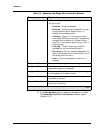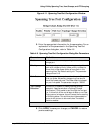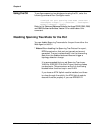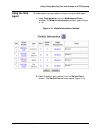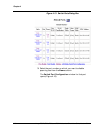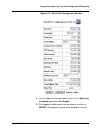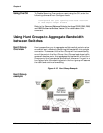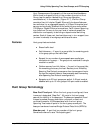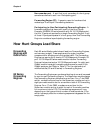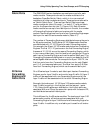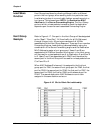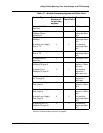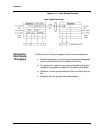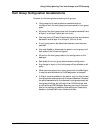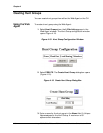
Avaya P550R, P580, P880, and P882 Multiservice Switch User Guide, Version v5.3.1 4-29
Using VLANs, Spanning Tree, Hunt Groups, and VTP Snooping
Hunt Groups expand the capacity of the core switched backbone.
While there is no specific limit on the number of ports in a Hunt
Group (see the section labeled Hunt Group configuration
considerations). In the example, (Figure 4-17), the Hunt Group
consists of two full-duplex Gigabit Ethernet links shared between
two switches, for an aggregate capacity of 4 Gbps. Enterprise-level
servers can be directly attached to the switching core using either
100 Mbps or Gigabit Ethernet connections. Fault-tolerant spanning
tree links from the core to the next level of network spread the
distribution and capacity to building or departmental switching
centers. Each of these next-level switches may in turn support tens
(or even hundreds) of workgroup switches and users.
Features Hunt group features include:
■ Shared traffic load.
■ Fault tolerance — If a port in a group fails, the remaining ports
in the group pick up the traffic load.
■ Support for any number of same-speed same media type
connections in a group — The group is not restricted to a single
module in a switch.
■ Quicker recovery from link failure — If a port in the group fails,
the remaining ports carry the load. Recovery is not limited by
Spanning Tree Protocol convergence time (convergence time is
the time the network takes to resume steady-state forwarding
after Spanning Tree Protocol reconfiguration).
■ Supports up to 25 hunt groups per switch, if 48-port mode is
disabled and up to 13 hunt groups if 48-port mode is enabled.
Hunt Group Terminology
Base Port/Flood port- When the hunt group is configured, there
is one port designated “Base Port”. All ports in the hunt group
assume the identity of the base port. The base port passes all flood
frames, broadcast frames, destination unknown unicast, and
multicast frames for VLANs associated with the hunt group.
Spanning Tree treats all ports in the hunt group as one port. The
base port sends and receives Bridge Protocol Data Units (BPDU’s).
Member port - A port that is a member of the hunt group.
Sometimes referred to as a “Participating port”.




